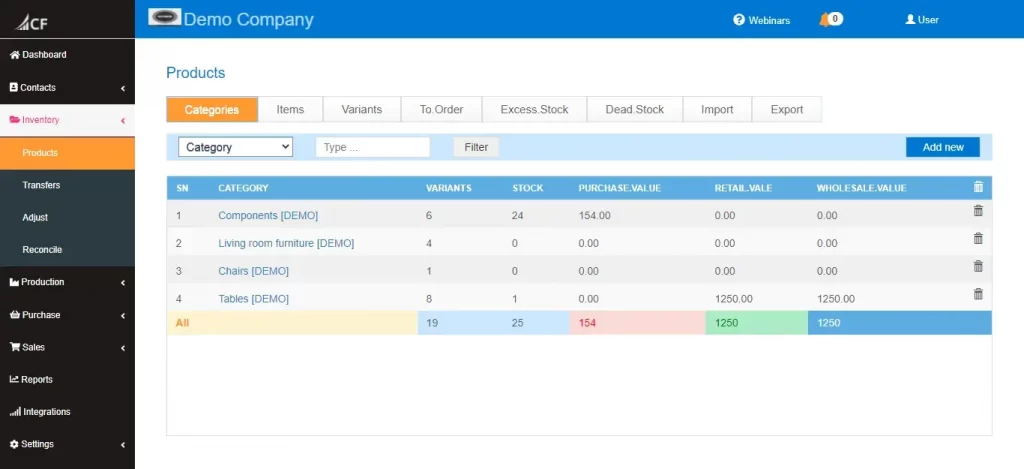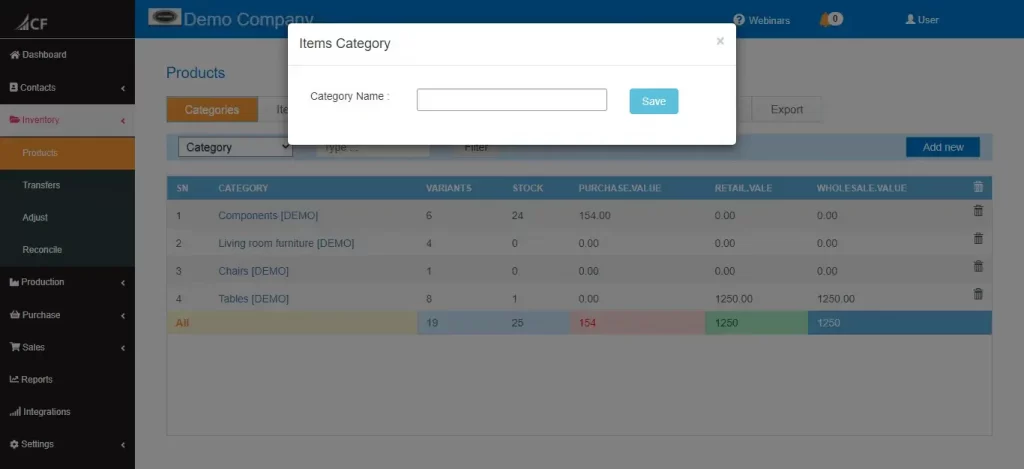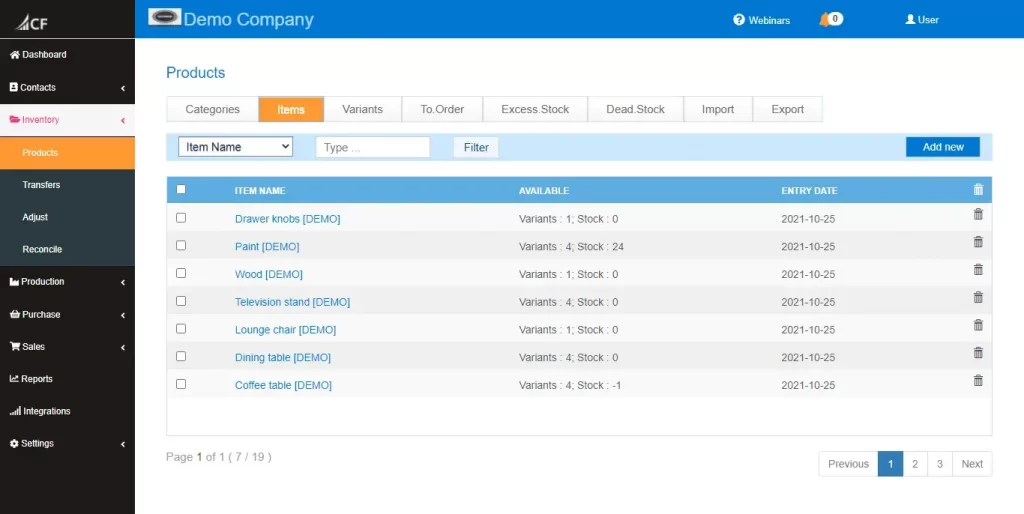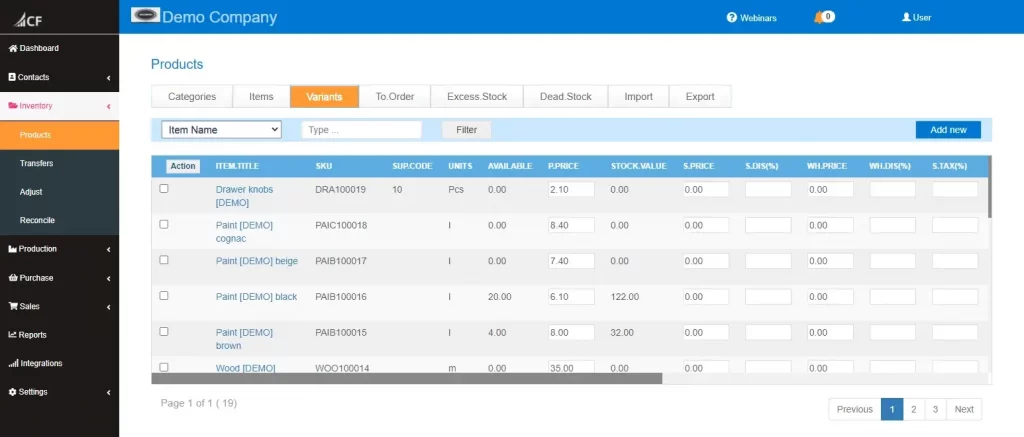Editorial Note: We are an inventory management software provider. While some of our blog posts may highlight features of our own product, we strive to provide unbiased and informative content that benefits all readers.
Cash Flow Inventory manage your products categories, suppliers, pricing, availability with easy and effective features that ensure business’s overall success.
How to manage Products in Cash Flow Inventory :
Login> Dashboard > Inventory> Products
Product Categories:
A product category is a type of products. Product categories are typically created by a firm or industry organization to organize products. Alternatively, product categories can be a flat structure such as a list of product types. The following are common types of product category.

Product Categories : Add New
Click the “Add new” button (in the right side / right bottom corner for mobile view). A pop-up window opens.

Type new category name and click save to store.
Product Categories : Edit
You can not edit or rename a category. When you add a new category but yet not start entry under the category, you can delete it (if you entry wrong spelling) and can add new one.
Product Categories : Delete a Category
In the right side of category list have a delete icon

You can not delete a category when a category has items and variants.
First you have to delete those variants and items under the category then you can delete that category.
Product Items
In cash Flow Inventory, A product is a physical item to the sale. Items may have different sizes and colors. Every product is made at a cost (maybe purchase directly or purchase raw materials and produced finished products )and each is sold at a price. Sold prices are two types retail and wholesale. A business may have only retail or only wholesale price. In that cases, the two prices are the same.
You can manage items (with different variants) like items, variants, all related info including suppliers, stocks, purchases, sales, replacements, returns, transfers, adjusts (may be damage or counting errors), discounts & pricing control, bar codes and QR codes, and all relative operations easily by Using Cash Flow Inventory.
How to Add Items & Variants :
Go to items tab.

Click the “Add new” button (in the right side / right bottom corner for mobile view). A pop-up window opens. You can also add items (with variants) from variants tab.

Add New Step One :

Type : Inventory or Non-Inventory or Service
- Inventory : Product’s stock you want to track.
- Non-Inventory : Product’s stock you don’t want to track.
- Service : These are not a physical product. May be any type of service.
Location : This is default location usually use, but you can manage orders other operations and can change default location anytime for any items. and opening stock (Problem)
Batch : Batch id not required, but if you want to track your batch (Lot) you can easily mange it using Cash Flow Inventory.
For managing expired dates you must be manage batches, rather you can use or ignore batch.
Servicing : If your products has after sales service like warranty or guarantee select one and entry the after sales servicing days. If you give 1 year warranty select service type warranty and servicing days 365.
Serials : Batch id not required. But the product need to track serial number for managing after sales service or for other reason select the serials yes and scan your serial numbers both stock in (Opening stock, Purchase, Sales return) and stock out(Sales, Purchase return).
Item Name : Item name is a required field field. You must fill the item name when adding a product.
SKU : SKU means stock keeping unit. It’s auto generated but you can change or edit it when adding your product.
If you using bar codes or QR Codes this SKU number is printed on bar code or QR Code tag and when you scan that tag using scanner (bar code or QR Code reader) you find the products for you operations like when purchasing, selling, transferring products.
Supplier Code : When you purchasing product sometimes it has a bar code or QR Code providing by manufacturers and if you don’t want to print your own tags rather you want to using these tags for managing (using scanner) sales, transfers give these code in the suppliers code filed when adding the product. Rather you can keep it empty.
Primary Unit : It’s a required filed. Primary unit is the base unit of measure like pcs, inches etc.
Weight Value : Weight value according to weight units (like gm, kg, oz) like 100 (Weight Value) gm (Weight Unit).
Weight Units : Weight unit per primary unit like gm, kg, oz etc.
Volume in m3 : Volume in metre3 per primary unit.
Variants : A product may have different types of variants like different sizes, colors or other type variants.
Forecasting : Forecasting is a technique that uses historical data as inputs to make informed estimates that are predictive in determining the direction of future trends. Businesses utilize forecasting to determine how to allocate their budgets or plan for anticipated expenses for an upcoming period of time.
Add New Step Two :

Edit a Variant :
Go to variants tab. Search an filter to find the variant and click the variant name. A pop-up window opens and it looks like this.

Click edit ( in the right side of page). A pop-up window opens (same as add new pop-up). Change information and save to store.
Delete Items & Variants :
Yon can delete an item if
the item has not any variants. if has variants first you have to delete variants. You can only delete a variant if the variant has not any entry like purchase, sales, transfer adjust.
Take a Quiz Test - Test Your Skill
Test your inventory management knowledge. Short multiple-choice tests, you may evaluate your comprehension of Inventory Management.
